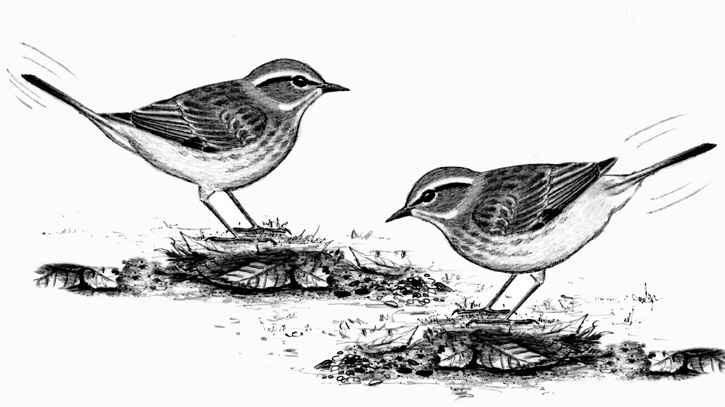
Dear Bird Folks,
What do Eastern Phoebes look like in the winter? Each year they nest on our back porch. Their energetic tail wagging is a welcomed sign of spring. This fall we’ve been seeing several of these wagging birds on the ground in our garden, only now they are not their usual bland gray. They have bright yellow on their tails. Why are their winter colors more vibrant than in the spring?
– Janet, Hampton, NH
No, it isn’t, Janet,
Gray is not a “bland” color. It’s exciting. It is the color of sophistication and distinction. It’s a sign of great wisdom and superior intellect. Actually, I don’t believe any of that. I’m just sucking up to my customer base. Around here gray is always the color du jour. Don’t get me wrong, I have the ultimate respect for anyone with gray hair. Heck, that could even be me someday. Oh, who am I kidding? I have so many gray hairs I look like a family of squirrels is living on my head.
The reason your Eastern Phoebes look so different in the fall is because they probably aren’t phoebes, eastern or any other direction. The birds you are seeing are more likely Palm Warblers. I know phoebes have the habit of wagging their tails, but Palm Warblers also wag their tails. (It’s just another thing they do to make bird watching even more difficult.) You said your fall birds had yellow tails and that sounds more Palm Warbler-ish and less phoebe-ish to me. The other reason I think you are seeing Palm Warblers is that they were feeding on the ground. That’s not the phoebe’s usual M.O. They typically sit on branches and wait for food to come to them. Palm Warblers are blue collar birds. They don’t mind getting dirty, rooting on the ground like sparrows. A Palm Warbler’s feeding behavior is very un-phoebe like…or even un-warbler like for that matter.
Most spring warblers are brilliantly colored birds that are fairly easy to identify. But by the time fall rolls around they have become a lot less brilliant and a lot trickier to ID. This is certainly true for Palm Warblers. Fortunately, the aforementioned tail wagging helps us with identification. (FYI: We call it tail “wagging” but it is really more of a bobbing, up and down motion, not side-to-side like a cocker spaniel’s tail.) The reason for all this tail wagging is not clear, but that doesn’t mean there aren’t theories. One of the most common theories has to do with feeding. It is thought the birds pump their tails in an effort to startle insects out of hiding. Other people suggest the birds wag their tails because they are happy. Happy? That’s just stupid.
Speaking of stupid, the common name of this bird is irrelevant because Palm Warblers don’t have anything to do with palms. They don’t nest in palm trees and can’t even palm a basketball. However, some of them do spend the winter on Caribbean islands. The name probably came about when some ornithologist saw a warbler while he was enjoying a piña colada at a Club Med. The guy apparently was too lazy to do any real research, so he named the bird “Palm Warbler” after the tree he was lying under. That’s my theory anyway. The Caribbean aside, the majority of these birds spend the winter along the southern U.S. coast where they wag away among all the human snowbirds. Come spring the birds head up to Canada to breed and continue their tail wagging, only now their wagging isn’t needed for identification. During the breeding season Palm Warblers are well-marked birds. They have streaky yellow chests and handsome rusty caps on their heads, making them look like bellhops at an old time Hollywood hotel.
Earlier we mentioned that these warblers like to feed on the ground, the same is true for their nests. A little cup of grass at the base of a bush is all they need to raise a family. Nesting on the ground makes the birds vulnerable to predators, but there are advantages to terra firma home construction. Many warbler species suffer when loggers turn their nesting trees into plywood and paper plates, but that’s not a problem for these ground-loving birds. Their population has remained stable while other warblers have declined. (Maybe tail wagging is the true secret to life.)
One thing Palm Warblers have in common with other warblers is that they spend most of their lives searching for insects. Nothing brightens their day more than finding a nice grasshopper or savory spider, but during the fall and winter seeds and berries also become part of their diet. They are one of the few warblers that aren’t ashamed to go veggie once in a while. (I like birds that have an open mind.)
Here in New England the best time to see Palm Warblers, Janet, is during migration, especially fall migration. They sometimes appear in our backyards, but they are more often seen in fields and thickets. In fact, for the past few weeks I have been birding many of the local community gardens. Every garden has had a large assortment of sparrows and a good number of Palm Warblers. Folks should check out these gardens, which are great places to see birds. Just be careful where you step. Last week I accidently stepped on a row of carrots and Mr. McGregor came chasing after me with a rake…and his tail definitely wasn’t wagging.